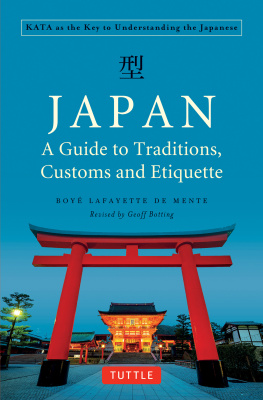A unique look at a unique culture. If youre trying to figure the Japanese out, this book provides another important piece of the puzzle.
Terrie Lloyd, Founder & Publisher, J@pan Inc.; CEO, LINC Media, Tokyo
Form (kata) over substance has long been a guidepost to understanding Japan, but Boy Lafayette De Mente, in KATA, paints a convincing picture of consciously nurtured forms prescribing behavior and methodology as a cultural and psychological hallmarkthe source of both great strengths and great limitations. Even long-time students of Japan will find the book illuminating and thought-provoking.
Sam Jameson, former Tokyo Bureau Chief of the Chicago Tribune and the Los Angeles Times
Among the numerous books by foreigners on the intricate Japanese mindscapes and businessscapes, Boy Lafayette De Mentes KATA: The Key to Understanding & Dealing with the Japanese! is undoubtedly the most informative and eye-opening; it is rich in exploratory insight and provocative wisdom.
Dr. Tae-Chang Kim, President, Institute for the Integrated Study of Future Generations, Kyoto
In working with the most traditional sectors of the Japanese economy (real estate and construction), where few foreigners ever penetrate, I have experienced the gorge of misunderstanding between Japan and the rest of the world. KATA explains the rationale for Japanese behavior and fills in the blanks for everyone, including long-term foreign residents.
James Fink, General Manager, Colliers Halifax, Tokyo
I have been acting as a bridge between Japanese and foreign businessmen for nearly forty years. This book says what I have been trying to say all those years.
Tokuo Maruoka, Former Director, Price Waterhouse Japan; Founder & Chairman, Comito Inc., Tokyo
Even long-time students of Japan will find the book illuminating and thought-provoking.
Sam Jameson, former Tokyo Bureau Chief of the Chicago Tribune and the Los Angeles Times
KATA explains the rationale for Japanese behavior and fills in the blanks for everyone, including long-term foreign residents.
James Fink, General Manager, Colliers Halifax, Tokyo

KATA as the Key to Understanding the Japanese
JAPAN
A Guide to Traditions, Customs and Etiquette
BOY LAFAYETTE DE MENTE
Revised by Geoff Botting

ABOUT TUTTLE
Books to Span the East and West
Our core mission at Tuttle Publishing is to create books which bring people together one page at a time. Tuttle was founded in 1832 in the small New England town of Rutland, Vermont (USA). Our fundamental values remain as strong today as they were thento publish best-in-class books informing the English-speaking world about the countries and peoples of Asia. The world has become a smaller place today and Asias economic, cultural and political influence has expanded, yet the need for meaningful dialogue and information about this diverse region has never been greater. Since 1948, Tuttle has been a leader in publishing books on the cultures, arts, cuisines, languages and literatures of Asia. Our authors and photographers have won numerous awards and Tuttle has published thousands of books on subjects ranging from martial arts to paper crafts. We welcome you to explore the wealth of information available on Asia at www.tuttlepublishing.com.
Published by Tuttle Publishing, an imprint of Periplus Editions (HK) Ltd.
www.tuttlepublishing.com
Text Boy Lafayette De Mente, 2017 First Tuttle edition, 2013
All rights reserved. No part of this publication may be reproduced or utilized in any form or by any means, electronic or mechanical, including photocopying, recording, or by any information storage and retrieval system, without prior written permission of the publisher.
ISBN 978-4-8053-1442-5
(Previously published as KATA, Isbn 978-0-8048-3386-8, LCC Card No. 2004267142 and ISBN 978-4-8053-1105-9 (for sale in Japan only)
20 19 18 17 8 7 6 5 4 3 2 1 Printed in Singapore 1710MP
TUTTLE PUBLISHING is a registered trademark of Tuttle Publishing, a division of Periplus Editions (HK) Ltd.
Distributed by:
North America, Latin America and Europe
Tuttle Publishing
364 Innovation Drive
North Clarendon, VT 05759-9436
Tel: 1 (802) 773 8930
Fax: 1 (802) 773 6993
www.tuttlepublishing.com
Japan
Tuttle Publishing
Yaekari Building 3F, 5-4-12 Osaki
Shinagawa-ku, Tokyo 141-0032
Tel: (81) 3 5437 0171
Fax: (81) 3 5437 0755
www.tuttle.co.jp
Asia Pacific
Berkeley Books Pte Ltd
61 Tai Seng Ave #02-12
Singapore 534167
Tel: (65) 6280 1330
Fax: (65) 6280 6290
www.periplus.com
Foreword
Dispelling the Enigma Myth of Japan
T RADITIONALLY, the Japanese were an enigma to the West. When Westerners first encountered the Japanese in the 16th century, the differences in their attitudes and behavior were so profound and conspicuous that these early visitors were either shocked or delighted, depending on the circumstances.
The Japanese not only bathed daily, both genders bathed together. Prostitution districts were a part of the national infrastructure. Regular sexual release was regarded as essential for ones physical and mental health.
Samurai warriors were legally permitted to kill anyone on the spot who ignored rules of etiquette. The Shogunate government and provincial lords engaged the services of ninja (neen-jah), or professional assassins. It was a capital offense to teach foreigners the Japanese language. From the late 1630s to the mid-1850s, any Japanese who left the country and returned was subject to the death penalty.
The Japanese routinely appeared to be incapable of telling the truth, even in situations where there was nothing to be gained from lying. Facts were ignored, and face was more important than life itself.
These customs and mind-set resulted in Westerners assuming that there was something mysterious in the makeup of the Japanese character that accounted for their extra-ordinary behavior. This led to the creation of a mystery of the Orient myth that became a primary theme in Western writings on Japan, profoundly influencing all of our relations with the Japanese.
To complicate matters further, the Japanese themselves historically suffered from a similar malady that might be called the mystery of the West. Their view of the Western world was just as distorted as the Westerners view of them.
Noting this phenomenon in the late 1960s, Japanologist George H. Lambert observed that they (the Japanese) often reacted to Westerners on the basis of old and well-preserved stereotypes with behavioral patterns that were incompatible with their normal conduct. Thus, he added, it often happens that we are reacting to abnormal Japanese behavior that is in itself a reaction to us.
In fact, the Japanese have always been among the most explainable people on Earth due to their deeply entrenched custom of formalized role-playing, which influenced every aspect of their attitudes and behavior. The mystery that blocked the Westerners view and understanding of the Japanese was simply their own veil of cultural myopia; their own ignorance of the essence of the Japanese way of thinking and doing things.
Today, despite the fact that Japan has become the worlds third largest economy and the variety and volume of exchanges between Japan and the rest of the world are awesome, culture-based problems continue to cause misunderstandings and mistakesby both Japanese and their foreign counterparts.
Next page















